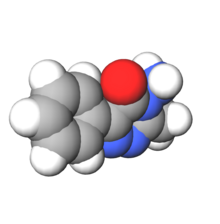Chemistry:Metamitron

| |

| |
| Names | |
|---|---|
| Preferred IUPAC name
4-amino-3-methyl-6-phenyl-1,2,4-triazin-5-one | |
| Other names
Metamiton
Methiamitron 4-Amino-3-methyl-6-phenyl-1,2,4-triazin-5-one 4-Amino-3-methyl-6-phenyl-1,2,4-triazin-5(4H)-one Goltix Herbrak | |
| Identifiers | |
3D model (JSmol)
|
|
| ChEBI | |
| ChEMBL | |
| ChemSpider | |
| EC Number |
|
| KEGG | |
PubChem CID
|
|
| RTECS number |
|
| UNII | |
| |
| |
| Properties | |
| C10H10N4O | |
| Molar mass | 202.217 g·mol−1 |
| Appearance | Colorless-to-yellow crystals[1] |
| Density | 600 kg/m3 |
| Melting point | 167[1] °C (333 °F; 440 K) |
| 0.17% (20 °C)[1] | |
| Vapor pressure | 0.00000086 Pa (20 °C)[1] |
Except where otherwise noted, data are given for materials in their standard state (at 25 °C [77 °F], 100 kPa). | |
| Infobox references | |
Metamitron is an organic compound used as a selective pre- and post-emergence herbicide in sugar beets.[2][3] It is used in the European Union for weed suppression in sugar beets.[3] Metamitron is marketed under the trade name Goltix by ADAMA in Europe, the United Kingdom ,[4] New Zealand, and South Africa .
Metamitron is a triazinone herbicide. It possesses a triazine ring like other organic compounds that use cyanuric chloride as a precursor. It is a modification of the chemical 1,2,4-triazin-5(4H)-one, with methyl, amino, and phenyl group substitutions at positions 3, 4, and 6.[1]
Metamitron is in the HRAC Mode of action Group 5.[5] It functions as an inhibitor of PSII by binding to serine 264 on the D1 protein.[6] Resistance to metamitron has been found in Chenopodium album growing as weeds among sugar beet fields in Belgium, caused by a mutation in serine 264.[2][6]
Metamitron has moderate acute oral and inhalation toxicity.[1]
See also
References
- ↑ 1.0 1.1 1.2 1.3 1.4 1.5 "Metamitron" (in en). https://pubchem.ncbi.nlm.nih.gov/compound/38854.
- ↑ 2.0 2.1 Mechant, Els (January 2011). Metamitron resistant Chenopodium album: characterisation, detection and distribution in Belgian sugar beet.. Ghent, Belgium: Ghent University. pp. 247. ISBN 978-90-5989-460-0. https://www.researchgate.net/publication/263353641. Retrieved 5 January 2024.
- ↑ 3.0 3.1 "Metamitron - an overview | ScienceDirect Topics". https://www.sciencedirect.com/topics/chemistry/metamitron.
- ↑ "GOLTIX® 70 SC | ADAMA" (in en). 4 October 2021. https://www.adama.com/uk/en/our-solutions/herbicides/goltix-70-sc.
- ↑ "Global Herbicide Classification Lookup". https://hracglobal.com/tools/classification-lookup/?s=metamitron&mode=&letter=&number=#classificationLookup.
- ↑ 6.0 6.1 Thiel, Heike; Kluth, Christian; Varrelmann, Mark (September 2010). "A new molecular method for the rapid detection of a metamitron-resistant target site in Chenopodium album". Pest Management Science 66 (9): 1011–1017. doi:10.1002/ps.1975. PMID 20730994. https://pubmed.ncbi.nlm.nih.gov/20730994/. Retrieved 6 January 2024.
 |

